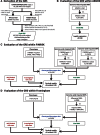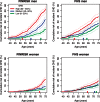Genomic prediction of coronary heart disease - PubMed (original) (raw)
Meta-Analysis
. 2016 Nov 14;37(43):3267-3278.
doi: 10.1093/eurheartj/ehw450. Epub 2016 Sep 21.
Aki S Havulinna 3, Oneil G Bhalala 1 2, Sean G Byars 1 2, Alysha M De Livera 1 2 4, Laxman Yetukuri 5, Emmi Tikkanen 5, Markus Perola 3 5, Heribert Schunkert 6 7, Eric J Sijbrands 8, Aarno Palotie 5 9 10 11, Nilesh J Samani 12 13, Veikko Salomaa 14, Samuli Ripatti 15 16 17, Michael Inouye 18 2 4
Affiliations
- PMID: 27655226
- PMCID: PMC5146693
- DOI: 10.1093/eurheartj/ehw450
Meta-Analysis
Genomic prediction of coronary heart disease
Gad Abraham et al. Eur Heart J. 2016.
Abstract
Aims: Genetics plays an important role in coronary heart disease (CHD) but the clinical utility of genomic risk scores (GRSs) relative to clinical risk scores, such as the Framingham Risk Score (FRS), is unclear. Our aim was to construct and externally validate a CHD GRS, in terms of lifetime CHD risk and relative to traditional clinical risk scores.
Methods and results: We generated a GRS of 49 310 SNPs based on a CARDIoGRAMplusC4D Consortium meta-analysis of CHD, then independently tested it using five prospective population cohorts (three FINRISK cohorts, combined n = 12 676, 757 incident CHD events; two Framingham Heart Study cohorts (FHS), combined n = 3406, 587 incident CHD events). The GRS was associated with incident CHD (FINRISK HR = 1.74, 95% confidence interval (CI) 1.61-1.86 per S.D. of GRS; Framingham HR = 1.28, 95% CI 1.18-1.38), and was largely unchanged by adjustment for known risk factors, including family history. Integration of the GRS with the FRS or ACC/AHA13 scores improved the 10 years risk prediction (meta-analysis C-index: +1.5-1.6%, P < 0.001), particularly for individuals ≥60 years old (meta-analysis C-index: +4.6-5.1%, P < 0.001). Importantly, the GRS captured substantially different trajectories of absolute risk, with men in the top 20% of attaining 10% cumulative CHD risk 12-18 y earlier than those in the bottom 20%. High genomic risk was partially compensated for by low systolic blood pressure, low cholesterol level, and non-smoking.
Conclusions: A GRS based on a large number of SNPs improves CHD risk prediction and encodes different trajectories of lifetime risk not captured by traditional clinical risk scores.
Keywords: Coronary heart disease; Framingham risk score; Genomic risk score; Myocardial infarction; Primary prevention.
© The Author 2016. Published by Oxford University Press on behalf of the European Society of Cardiology.
Figures
Figure 1
Study workflow. (A) The procedure for deriving the GRS of incident CHD. The analysis workflow for evaluating the GRS within (B) ARGOS, (C) FINRISK, and (D) FHS.
Figure 2
Difference in C-index (95% CI) for time to incident CHD event within 10 years, relative to the reference model in the FINRISK and FHS cohorts. Reference models used age as the time scale, stratified by sex (FINRISK: adjusted for cohort and geographic location; FHS: adjusted for cohort). Family history was not available for all of the FHS cohorts and thus not considered here. _P_-values are from the correlated jackknife test.
Figure 3
Kaplan-Meier cumulative risk of incident CHD event by genomic risk group for men and women in the FINRISK and FHS cohorts. Showing the cumulative risk in quintiles 0–20%, 40–60%, 80–100%. The vertical bars along the x-axis indicate the age at which each risk group attains a cumulative CHD risk of 10%. Dashed lines indicate 95% CI.
Figure 4
Kaplan-Meier curves for incident CHD event risk stratified by GRS quintiles and smoking status at baseline, for men and women in the FINRISK cohorts.
Comment in
- Genetic cardiovascular risk prediction: are we already there?
Assimes TL, Goldstein BA. Assimes TL, et al. Eur Heart J. 2016 Nov 14;37(43):3279-3281. doi: 10.1093/eurheartj/ehw498. Epub 2016 Oct 25. Eur Heart J. 2016. PMID: 27940815 Free PMC article. No abstract available.
Similar articles
- Incremental predictive value of 152 single nucleotide polymorphisms in the 10-year risk prediction of incident coronary heart disease: the Rotterdam Study.
de Vries PS, Kavousi M, Ligthart S, Uitterlinden AG, Hofman A, Franco OH, Dehghan A. de Vries PS, et al. Int J Epidemiol. 2015 Apr;44(2):682-8. doi: 10.1093/ije/dyv070. Epub 2015 May 6. Int J Epidemiol. 2015. PMID: 25953786 - Association between parental history and genetic risk scores for coronary heart disease prediction: The population-based CoLaus study.
Antiochos P, Marques-Vidal P, McDaid A, Waeber G, Vollenweider P. Antiochos P, et al. Atherosclerosis. 2016 Jan;244:59-65. doi: 10.1016/j.atherosclerosis.2015.10.104. Epub 2015 Nov 3. Atherosclerosis. 2016. PMID: 26584140 - A genetic risk score based on direct associations with coronary heart disease improves coronary heart disease risk prediction in the Atherosclerosis Risk in Communities (ARIC), but not in the Rotterdam and Framingham Offspring, Studies.
Brautbar A, Pompeii LA, Dehghan A, Ngwa JS, Nambi V, Virani SS, Rivadeneira F, Uitterlinden AG, Hofman A, Witteman JC, Pencina MJ, Folsom AR, Cupples LA, Ballantyne CM, Boerwinkle E. Brautbar A, et al. Atherosclerosis. 2012 Aug;223(2):421-6. doi: 10.1016/j.atherosclerosis.2012.05.035. Epub 2012 Jun 12. Atherosclerosis. 2012. PMID: 22789513 Free PMC article. - Incremental Value of Polygenic Risk Scores in Primary Prevention of Coronary Heart Disease: A Review.
Groenendyk JW, Greenland P, Khan SS. Groenendyk JW, et al. JAMA Intern Med. 2022 Oct 1;182(10):1082-1088. doi: 10.1001/jamainternmed.2022.3171. JAMA Intern Med. 2022. PMID: 35994254 Review. - How close are we to implementing a genetic risk score for coronary heart disease?
Beaney K, Drenos F, Humphries SE. Beaney K, et al. Expert Rev Mol Diagn. 2017 Oct;17(10):905-915. doi: 10.1080/14737159.2017.1368388. Epub 2017 Sep 4. Expert Rev Mol Diagn. 2017. PMID: 28816567 Review.
Cited by
- Coronary Artery Disease, Family History, and Screening Perspectives: An Up-to-Date Review.
Di Lenarda F, Balestrucci A, Terzi R, Lopes P, Ciliberti G, Marchetti D, Schillaci M, Doldi M, Melotti E, Ratti A, Provera A, Paolisso P, Andreini D, Conte E. Di Lenarda F, et al. J Clin Med. 2024 Sep 30;13(19):5833. doi: 10.3390/jcm13195833. J Clin Med. 2024. PMID: 39407893 Free PMC article. Review. - Identifying and characterizing disease subpopulations that most benefit from polygenic risk scores.
Isgut M, Giuste F, Gloster L, Swain A, Choi K, Hornback A, Deshpande SR, Wang MD. Isgut M, et al. Sci Rep. 2024 Sep 27;14(1):22124. doi: 10.1038/s41598-024-63705-5. Sci Rep. 2024. PMID: 39333190 Free PMC article. - Integrative genetic analysis: cornerstone of precision psychiatry.
Vorstman J, Sebat J, Bourque VR, Jacquemont S. Vorstman J, et al. Mol Psychiatry. 2024 Aug 30. doi: 10.1038/s41380-024-02706-2. Online ahead of print. Mol Psychiatry. 2024. PMID: 39215185 Review. - Genome-wide DNA methylation profiling in blood reveals epigenetic signature of incident acute coronary syndrome.
Long P, Si J, Zhu Z, Jiang Y, Wang Y, Jiang Q, Li W, Xu X, You Y, Qu M, Wang H, Mo T, Liu K, Jiang J, Wang Q, Yu C, Guo Y, Millwood IY, Walters RG, He X, Yuan Y, Wang H, Zhang X, He M, Guo H, Chen Z, Li L, Lv J, Wang C, Wu T. Long P, et al. Nat Commun. 2024 Aug 28;15(1):7431. doi: 10.1038/s41467-024-51751-6. Nat Commun. 2024. PMID: 39198424 Free PMC article. - Using polygenic scores in combination with symptom rating scales to identify attention-deficit/hyperactivity disorder.
Høberg A, Solberg BS, Hegvik TA, Haavik J. Høberg A, et al. BMC Psychiatry. 2024 Jun 27;24(1):471. doi: 10.1186/s12888-024-05925-7. BMC Psychiatry. 2024. PMID: 38937684 Free PMC article.
References
- Goff DC, Jr, Lloyd-Jones DM, Bennett G, Coady S, D'agostino RB, Gibbons R, Greenland P, Lackland DT, Levy D, O'donnell CJ, Robinson JG, Schwartz JS, Shero ST, Smith SC, Jr, Sorlie P, Stone NJ, Wilson PW, Jordan HS, Nevo L, Wnek J, Anderson JL, Halperin JL, Albert NM, Bozkurt B, Brindis RG, Curtis LH, DeMets D, Hochman JS, Kovacs RJ, Ohman EM, Pressler SJ, Sellke FW, Shen WK, Smith SC, Jr, Tomaselli GF. 2013 ACC/AHA guideline on the assessment of cardiovascular risk: a report of the American College of Cardiology/American Heart Association task force on practice guidelines. Circulation 2014;129(25 Suppl 2):S49–S73. - PubMed
- Stone NJ, Robinson JG, Lichtenstein AH, Bairey Merz CN, Blum CB, Eckel RH, Goldberg AC, Gordon D, Levy D, Lloyd-Jones DM, McBride P, Schwartz JS, Shero ST, Smith SC, Jr, Watson K, Wilson PW, Eddleman KM, Jarrett NM, LaBresh K, Nevo L, Wnek J, Anderson JL, Halperin JL, Albert NM, Bozkurt B, Brindis RG, Curtis LH, DeMets D, Hochman JS, Kovacs RJ, Ohman EM, Pressler SJ, Sellke FW, Shen WK, Smith SC, Jr, Tomaselli GF. 2013 ACC/AHA guideline on the treatment of blood cholesterol to reduce atherosclerotic cardiovascular risk in adults: a report of the American College of Cardiology/American Heart Association Task Force on Practice Guidelines. Circulation 2014;129(25 Suppl 2):S1–45. - PubMed
- Expert Panel on Detection, Evaluation, and Treatment of High Blood Cholesterol in Adults. Executive Summary of The Third Report of The National Cholesterol Education Program (NCEP) Expert Panel on Detection, Evaluation, And Treatment of High Blood Cholesterol In Adults (Adult Treatment Panel III). JAMA 2001;285:2486–2497. - PubMed
- Marenberg ME, Risch N, Berkman LF, Floderus B, de Faire U. Genetic susceptibility to death from coronary heart disease in a study of twins. N Engl J Med 1994;330:1041–1046. - PubMed
Publication types
MeSH terms
LinkOut - more resources
Full Text Sources
Other Literature Sources



